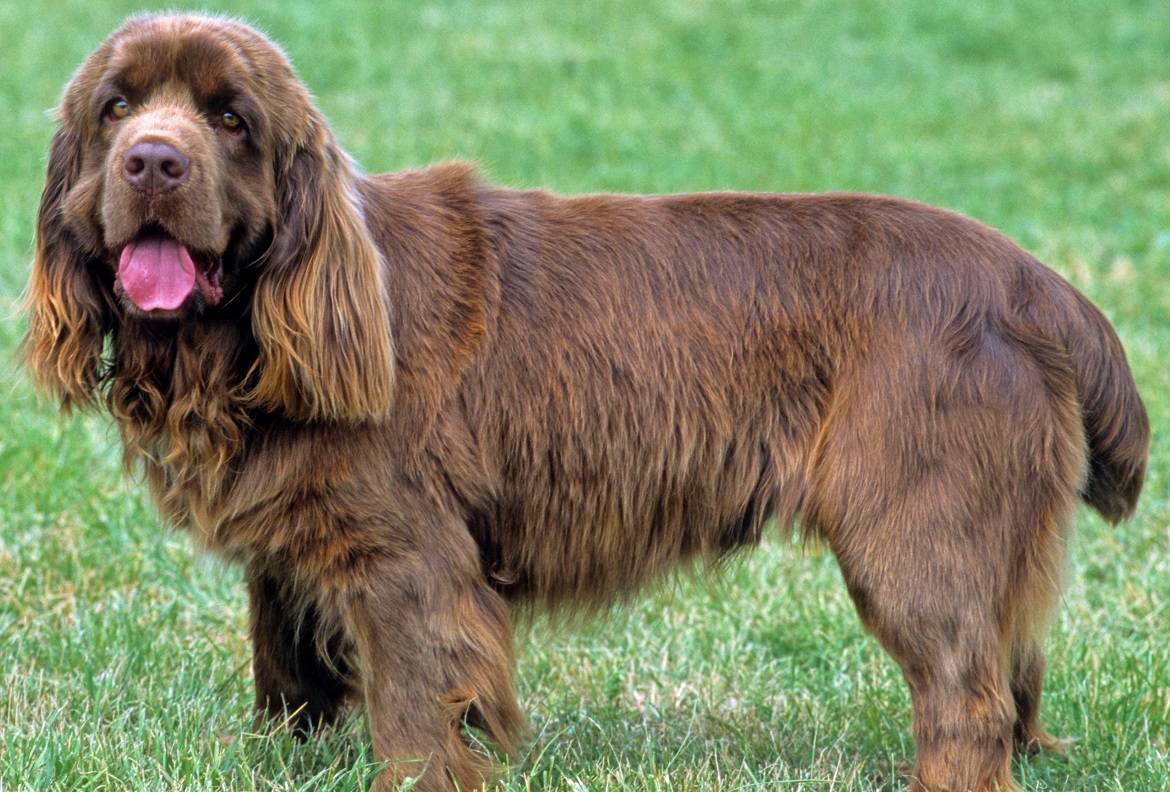
Paws ‘N’ Pups Quickview
Size
| Energy Level
| Trainability
| Paws ‘N’ Pups Rank
|
Characteristics
| Physical Characteristics: Height: 13-15” Weight: 35-45 lbs. Energy Level: Moderate | Colors: The American Kennel Club recognizes the Sussex Spaniel in the following colors:
|
Health & Longevity
Average Life Span: 10-15 years
Most Sussex Spaniels are healthy dogs, but several health problems may impact some members of this breed.
Hip dysplasia, a degenerative condition in which the hip joint is malformed and does not allow the thighbone to fit properly into place, can be an issue for some Sussex Spaniels. Hip dysplasia can lead to discomfort, pain, and limping. In more severe cases, arthritis or even lameness can result, and surgery may be required.
Eye problems like entropion and retinal dysplasia may also occur in the Sussex Spaniel. Entropion is when the lower eyelid rolls inward towards the eyeball, often causing the eyelashes to scratch or irritate its surface. This can ultimately cause damage to the cornea. In mild cases, entropion can be treated with artificial tears to lubricate the eye, but surgery is often required. Retinal dysplasia causes folds to form in the retinal tissue. Although it is not progressive or painful, it can cause vision problems for the affected dog. There are three types of retinal dysplasia, the most severe of which results in detachment of the retina and blindness. There is no cure or treatment for retinal dysplasia.
The Sussex Spaniel may also experience heart issues such as cardiomyopathy, pulmonic stenosis, and patent ductus arteriosus. Cardiomyopathy is characterized by an enlarged heart and can lead to shortness of breath, loss of appetite, and lethargy. Cardiomyopathy will likely be treated with diuretics, vasodilators, and other medications. Pulmonic stenosis is a congenital heart defect that causes obstruction of blood through the heart and can lead to a heart murmur or even heart failure. Surgery will likely be required. Patent ductus arteriosus, another congenital heart defect, causes abnormal blood flow in the heart and can cause breathing distress, stunted growth, and a rapid heartbeat. Surgery will likely be required after nitrates, oxygen therapy, and rest.
A back problem called Intervertebral Disc Disease (IVDD) might affect some Sussex Spaniels. IVDD is caused when a disc in the spinal cord degenerates or ruptures, causing pain, nerve damage, and sometimes paralysis. Treatment can involve medication or surgery, depending on the severity of the condition.
Other possible health problems for the Sussex Spaniel include exercise intolerance syndrome and deafness. Females sometimes have a difficult time whelping and will require caesarean sections.
The average lifespan for a Sussex Spaniel is 10-15 years.
Temperament & Train-ability
The Sussex Spaniel is calmer than most spaniels but is still friendly, cheerful and good-natured. He is relaxed indoors, but loves to be outside and becomes more energetic outdoors. He is a loving dog, but he does have a slight stubborn streak.
The Sussex Spaniel can live in an apartment as long as he is adequately exercised. Originally bred to hunt game birds, he does need plenty of activity. He also needs to be regularly exercised to prevent this natural chubbiness from turning to obesity. He should have at least 20-30 minutes of exercise daily. Although the Sussex Spaniel is not much of a runner, he will enjoy walks, hikes, and ball games. He can play dog sports like hunt tests, tracking, obedience, and rally. Although he is energetic, the Sussex Spaniel is not fast. He loves the outdoors and should spend time outside of the home daily, but his living space should be indoors with his beloved family. The Sussex Spaniel will become miserable if left outside without adequate companionship. He does bark and howl, especially if left alone for long periods of time, and he can become destructive when bored or lonely. The Sussex Spaniel is also likely to slobber and drool, so be prepared to clean up after him and wipe his face as needed.
The cheerful Sussex Spaniel is great with children when he is raised with them. However, as puppies, they may be too rambunctious for toddlers and young children. Although they are sometimes overly energetic as puppies, they do become very calm with age and are even used as therapy dogs regularly. Although he is aloof with strangers and can be territorial and protective of his family, the Sussex Spaniel often becomes lovable and polite once he gets to know someone. Unlike other spaniels, he can be aggressive with unfamiliar dogs if he is not properly socialized. He also may chase smaller animals. Proper socialization is necessary to ensure appropriate behavior from your Sussex Spaniel, so begin exposing him at a young age to a wide variety of sights, smells, people, places, and pets.
The stubborn and sometimes dominant Sussex Spaniel requires a firm and consistent trainer. He can be manipulative and may take advantage of a trainer who is timid or not confident. Be consistent in enforcing your rules and regulations so your Sussex Spaniel knows that you mean what you say. Keep sessions upbeat and use positive reinforcement like favorite treats, extra playtime or time outdoors, and verbal praise. The Sussex Spaniel is a prideful dog who will not respond well to harsh treatment. This breed is slow to mature and training and housebreaking him will require time, patience, and humor.
Grooming
The Sussex Spaniel has a silky coat that can become matted easily and sheds moderately. His coat should be brushed 1-2 times weekly. Daily brushing can be even better to help reduce hair being shed on the floor and furniture because he does shed quite a bit.
Bathe the Sussex Spaniel as needed. His fast-growing nails may need to be trimmed every two weeks to prevent overgrowth and cracking. Check his ears regularly for signs of infection like redness, tenderness, and odor. Brush his teeth at least 2-3 times weekly to maintain good overall health and prevent bad breath.
Diet
On average, the Sussex Spaniel should consume 2 cups of high-quality dry dog food daily. The exact type and amount of food for your individual dog will depend on factors like age, weight, metabolism, and activity level. The Sussex Spaniel can become overweight easily, so monitor his weight and food intake.
Ensure that your dog has access to clean, fresh drinking water at all times.
Looking for a Sussex Spaniel?
 Find A Sussex Spaniel Breeder |  Sussex Spaniel Puppies For Sale |  Adopt A Sussex Spaniel |
Cost
Although fewer than 70 Sussex Spaniel pups are registered in the United States annually, they still only cost an average of $500-$700. Be prepared to spend time on a waiting list.
If you can adopt a Sussex Spaniel, expect adoption fees costing up to $175.
Paws ‘N’ Pups Ranking
Paws ‘N’ Pups ranks every breed out of 4 with 1 being easiest to integrate into your life and 4 being the toughest – The lower the ranking the better.
Ranking takes into account a few basic factors including cost, skill level needed, high vs low maintenance and how critical regular training is to success. The Sussex Spaniel ranks a 4. Although he is loving and has only moderate exercise needs, he may develop separation anxiety and become noisy and destructive if left alone for long periods of time. He also needs extensive socialization to ensure appropriate behavior with people and pets, and training this stubborn, slow to mature breed may be a challenge. He slobbers and drools, and his high maintenance coat sheds quite a bit.
Breeds Similar To Sussex Spaniel
 Field Spaniel |  Clumber Spaniel |  English Cocker Spaniel |  Labrador Retriever |




